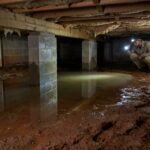Essential Guide to Foundation Repair: Ensuring Stability and Longevity for Your Home
When it comes to homeownership, few things are as daunting as discovering issues with your foundation. It’s the unsung hero of your home, tirelessly keeping everything above it in perfect alignment while you go about your daily life. But let’s face it—nobody wants to be the person saying, “Oh no, my house is sinking!” So, buckle up! In this essential guide to foundation repair, we’re going to explore what you need to know to ensure your home remains stable and secure for decades to come.
Understanding the Foundation of Your Home
Before diving into repairs, let’s establish what a foundation actually does. Think of it as your home’s sturdy pair of shoes, supporting everything from the walls to the roof. A solid foundation distributes the weight of your home evenly across the ground, allowing it to withstand various forces such as weather changes, soil movement, and even that adorable but clumsy Great Dane you call Max.
Typically, foundations come in several types:
1. **Basement Foundations**: These are ideal for homes built in colder climates and provide extra living space.
2. **Crawl Space Foundations**: These elevate the home above the ground, allowing for easier access to plumbing and electrical systems.
3. **Slab Foundations**: Common in warmer areas, a slab sits directly on the ground and requires minimal excavation.
Now that you’re equipped with some foundation trivia, let’s explore the signs of trouble.
Signs of Foundation Problems
Being able to identify potential issues early can save you a fortune (and a lot of headaches). Here are several warning signs that your foundation might be in distress:
1. **Cracks in Walls or Floors**: Small hairline cracks are common, but if they start resembling the Grand Canyon, it might be time to investigate.
2. **Doors and Windows that Stick**: If you find your doors and windows playing a game of “let’s see how slow we can open,” it might be due to shifting foundations affecting their alignment.
3. **Uneven Floors**: If you feel like you’ve stepped onto a badly maintained amusement park ride every time you walk through your home, this could indicate foundational issues.
4. **Water Accumulation**: Puddles forming in your crawl space or basement? Your home shouldn’t resemble a water park attraction!
5. **Gaps Between Walls and Ceilings**: If there are gaps big enough to house a family of squirrels between your walls and ceilings, it’s time to call in the experts.
If you notice any of these signs, don’t panic! But definitely don’t ignore them. Think of addressing foundation issues as giving your house a well-deserved check-up.
Common Causes of Foundation Issues
What causes these alarming signs, you ask? Various factors can wreak havoc on your home’s foundation:
– **Soil Movement**: Clay soils expand and contract with moisture levels, leading to movement and stress on your foundation. It’s nature’s version of a rollercoaster—but you certainly didn’t sign up for that!
– **Poor Drainage**: If rainwater isn’t diverted away from your home’s perimeter, over time, it can lead to erosion and foundation instability. Think of it as your home being caught in a perpetual water balloon fight!
– **Tree Roots**: While trees are lovely, their roots can cause significant damage by seeking moisture and nutrients beneath your home, potentially lifting or cracking the foundation.
– **Poor Construction Practices**: Sometimes, it just comes down to a lack of quality work during initial construction. An inferior foundation might be a sad gift from the previous homeowners.
Foundation Repair Solutions
Once you’ve diagnosed the problem, it’s time to delve into repair solutions, tailored to address the specific issues at hand. Your golden ticket to a stable foundation can include:
1. **Piering**: This technique involves digging holes around your foundation and inserting piers to lift and stabilize it. It’s like giving your home a sturdy walking cane.
2. **Slabjacking**: Also known as mudjacking, this involves injecting a substance beneath sunken concrete slabs to raise them back to their original position. What can we say? Sometimes your sidewalk needs a little supportive TLC.
3. **Wall Anchors**: For bowing or leaning walls, wall anchors can stabilize them and prevent further movement. Think of them as a fitness trainer for your walls, helping them stand tall and proud.
4. **Drainage Solutions**: Installing French drains, sump pumps, or re-grading your yard can help prevent water accumulation and subsequent foundation damage. This is akin to creating a moat – without the dragons, of course.
5. **Vapor Barriers**: For basements and crawl spaces, vapor barriers can prevent moisture infiltration, leading to a more stable environment. It’s like putting a raincoat on your foundation!
Choosing the Right Contractor
Finding the right contractor can feel like dating—there are plenty of options, but not all of them will sweep you off your feet. Here’s what to look for:
1. **Experience and Reputation**: Look for reviews, testimonials, and examples of previous work. A contractor with a solid reputation will give you peace of mind.
2. **Free Estimates**: A good contractor won’t hesitate to provide a free assessment of the damage and discuss potential solutions.
3. **Licensing and Insurance**: Ensure your contractor is licensed and insured to protect yourself and your investment. It’s like ensuring your plumber doesn’t have a side gig as a circus performer—safety first!
4. **Warranty Options**: Look for a contractor who offers warranties on their work. A reliable foundation repair company should stand behind their services.
5. **Written Contracts**: Finally, ensure everything discussed is in writing. No verbal agreements here! It’s not a secret handshake club.
Preventive Measures to Protect Your Foundation
After investing in foundation repair, it’s crucial to maintain its stability. Here are a few preventive measures to keep your home in tip-top shape:
1. **Proper Drainage**: Regularly check gutters and downspouts to ensure they direct water away from your foundation.
2. **Maintain Moisture Levels**: Keep your soil moist but not soggy during dry spells. A consistent moisture level protects against soil shrinkage.
3. **Landscaping Care**: Position trees and large shrubs at a safe distance from your foundation. You may love that towering oak, but it’s a little too cozy with your foundation.
4. **Regular Inspections**: Perform seasonal checks for cracks and other warning signs. Early detection can save you a fortune!
5. **Weatherproofing**: Insulate exposed pipes and ensure that your basement has adequate waterproofing to keep moisture at bay.
Conclusion
In conclusion, mastering the art of foundation repair is an essential part of homeownership. With a bit of knowledge and the right approach, you can ensure your home stays stable, safe, and standing tall for years to come. Remember that a strong foundation means more than just keeping your house upright; it enhances your property value, keeps your family comfortable, and gives you the peace of mind that comes from a well-maintained home.
So, take care of your foundation, and it will take care of you. And who knows? You might even end up developing a fondness for those cracks in your basement—after all, they could be the beginning of a very interesting story!


